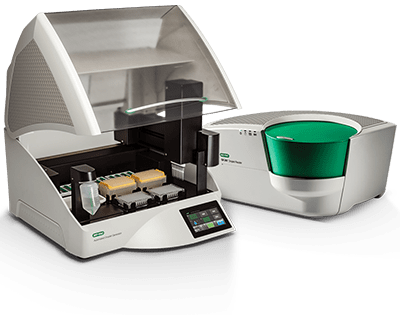
On This Page |
Case Study | Testimonials | QXDx Droplet Digital PCR System | Resources | Performance | Contact an Expert |
Monitoring minimal residual disease (MRD) is an important step in treating cancer patients. Expand your MRD testing capabilities and improve patient care with the power of Droplet Digital PCR (ddPCR). As part of the Bio-Rad Precision Monitoring portfolio, Bio-Rad's ddPCR hematology-oncology solutions provide results with industry-leading sensitivity, accuracy and unmatched precision, without the need for standard curves and extensive interpretation.
Discover the Power of using ddPCR for HemOnc Applications
For translational and clinical hematology-oncology (HemOnc) research, the ability to identify and measure rare nucleic acid sequences is essential. This capability allows reliable detection and monitoring of cancer, even when molecular markers are in very low abundance. As part of the Bio-Rad Precision Monitoring portfolio, Bio-Rad's proven Droplet Digital PCR (ddPCR) HemOnc solutions provide absolute quantification of amplified DNA and RNA with unmatched precision without standard curves.
A Case Study: ddPCR Precisely Detects BCR-ABL Fusion Transcripts in CML Patients
In a study carried out in 23 labs worldwide, researchers compared ddPCR to RT-qPCR for detecting BCR-ABL fusion transcripts, a hallmark of chronic myeloid leukemia (CML). Results indicate that quantifying samples directly with ddPCR (without the need for standard curves) reduced variability between labs and improved assay linearity compared to standard RT-qPCR. The ddPCR data demonstrated potential for a better classification of patients, aiding in the determination of early response to treatment and when to cease treatment.
Use of the CE-IVD QXDx BCR-ABL %IS Kit for this study elevates CML monitoring to a new level of precision with industry-leading sensitivity and reproducibility. Bio-Rad's BCR-ABL kit delivers a scalable and reliable approach for monitoring MRD in CML patients.
Testimonial by Dr. Simona Soverini

Simona Soverini, PhD
Assistant Professor of Hematology, University of Bologna
Institute of Hematology "Lorenzo e Ariosto Seragnoli"
Bologna, Italy"Droplet Digital PCR will become the method of choice for BCR-ABL1 TKD mutation testing: leading to sensitive and accurate screening for clinically actionable mutations using a faster, more cost-effective, and widely available technology. This is crucial for better management of tyrosine kinase inhibitor-resistant CML and Ph+ ALL patients across laboratories worldwide."
Would you explain what hematological conditions your laboratory focuses on and how Droplet Digital PCR fits into your lab workflow?
What advantages does Droplet Digital PCR offer over alternative techniques such as quantitative PCR (qPCR) and next generation (NGS)?
Do you have a specific example where Droplet Digital PCR has superseded the capabilities of next generation sequencing (NGS)? For example, tyrosine kinase inhibitor monitoring in acute lymphoblastic leukemias and chronic myeloid leukemia?
How do you see Droplet Digital PCR being further adopted in clinical hematology labs in Europe?
Testimonials

Dr. Liu Lu, PhD
SAHMRI
"We used the Bio-Rad ddPCR QXDx BCR-ABL %IS Kit to detect BCR-ABL1 MRD in CML patients. By using this technology we were able to identify BCR-ABL1 in many patients who were showing negative detection by qPCR at the time of TOC [time of cessation] when attempting TFR."

Daniela Drandi, PhD
Department of Molecular Biotechnology and Health Sciences
University of Torino"The remarkable sensitivity and accuracy of ddPCR enabled our laboratory to resolve indeterminate minimal residual disease measurements that we often generate with traditional qPCR protocols. The superior detection rate of ddPCR for MYD88 L265P in plasma provides a promising alternative to analyzing bone marrow aspirate in Waldenstrom Macroglobulinemia when assessing specimens with low concentrations of circulating tumour cells and associated ctDNA."
Meet the Bio-Rad QXDx Droplet Digital PCR System
The FDA-cleared Bio-Rad QXDx Droplet Digital PCR System features a simple, user-friendly, and scalable workflow to meet your throughput and detection needs for a broad range of hematology-oncology applications. It delivers absolute quantification of target DNA or RNA sequences for investigating hematologic malignancies such as:
| Hematologic Malignancies | Example Targets |
|---|---|
| ALL (acute lymphoblastic leukemia) | Fusion genes (e.g. p190 BCR-ABL) |
| AML (acute myeloid leukemia) | SNVs (e.g. IDH1 R132H), fusion genes |
| CML (chronic myeloid leukemia) | Fusion genes (e.g. p210 and p190 BCR-ABL) |
| MPN (myeloproliferative neoplasms) | SNVs (e.g. JAK2 V617F) |
| Waldenstrom macroglobulinemia | SNVs (e.g. MYD88 L265P) |
As the first FDA-cleared ddPCR system, the QXDx provides results with unmatched precision and industry-leading sensitivity and reproducibility. The dual-mode QXDx Manager software allows a user to operate in either a regulated or RUO environment. This unique platform allows the consolidation of instruments and streamlines workflows with the ability to run both in vitro diagnostic (IVD) and laboratory-developed tests (LDTs) on the same instrument. This capability is only available on the QXDx system, manufactured within rigorous GMP and ISO 13485 guidelines.
Key Features
- High throughput — each instrument run allows up to 96 individual reactions
- High accuracy and sensitivity — enriched template concentration in target-positive droplets, binary droplet fluorescent readout and absolute quantification provides greater accuracy and sensitivity than qPCR
- Removal of PCR bias — error rates are reduced by removing the reliance on amplification efficiency of individual qPCR assays and the generation of standard curves
- User-friendly workflow — streamlined workflow reduces hands-on-time and user burden
QXDx System Available in Two Formats for In-Vitro Diagnostics (IVD):
-

U.S. IVD
- Only includes the Automated Droplet Generator
- Open mode feature to enable lab-developed tests
-

CE IVD
- May include the Automated Droplet Generator or
the Manual Droplet Generator - Open mode feature to enable lab-developed tests
- May include the Automated Droplet Generator or
-

Questions on Droplet Digital PCR Systems?
Speak with an expert.
Resources

CAP and NEQAS Proficiency Schemes for BCR-ABL1
Unlike qPCR, Droplet Digital PCR does not require the use of a standard curve to generate absolute copy numbers. In this app note, see how you can reduce variability caused by inhibitors using Bio-Rad's Droplet Digital PCR technology.
Droplet Digital PCR Performance Using the QXDx BCR-ABL %IS Kit

Fig. 1. Consolidated data from QXDx BCR-ABL %IS Kit for both CAP and NEQAS. 0% IS values are represented in the timeline by blue stars. Measured BCR-ABL %IS values are represented in orange for CAP and yellow for NEQAS. Median returned values for BCR-ABL %IS are blue for CAP and green for NEQAS.
Analysis of samples for the CAP MRD-A BCR-ABL1 p210 quantitative scheme and the NEQAS-LI BCR-ABL1 Major Quantification program.
Samples obtained from each scheme (CAP & NEQAS) were analyzed with the Bio-Rad QXDx BCR-ABL %IS ddPCR kit from 2016 to 2020. BCR-ABL1 values generated on the International Scale (%IS) at the Digital Biology Centre are plotted against median %IS participant values calculated for each scheme.
How is Absolute Quantification Possible?
ddPCR is a robust method for monitoring cancer with high sensitivity and unmatched precision. The robustness of the technology and the simple workflow provide high levels of reproducibility and repeatability, ideal for international comparison of results. ddPCR also delivers absolute quantification by utilizing 20,000 individual emulsion PCR reactions per well, providing accurate results for both outright NA quantity and variant allele frequencies in cancer detection and minimal residual disease monitoring.
Sample partitioning is the key to ddPCR. While traditional PCR utilizes a single bulk PCR reaction, ddPCR uses advanced microfluidics technology to partition a single sample into 20,000 uniform, nanoliter-sized droplets for thousands of PCR reactions per well. Each amplified droplet is then interrogated for fluorescent signal of the target sequence, giving a binary call per droplet, allowing ddPCR to deliver incredible sensitivity.
Webinar

The Pathway to Accuracy with Droplet Digital PCR
See how you can monitor BCR-ABL1 MRD without standard curves. Watch this international inter-laboratory study and clinical laboratory monitoring webinar featuring an expert panel.
